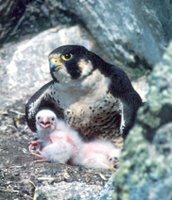News and links about birds, birding, and the environment.
 Chicago now has a downtown bird hospital during the migration seasons to treat birds that strike skyscrapers. Birds are checked for broken bones, treated with anti-inflammatory drugs, and allowed to rest before release. More information about the group running the hospital is available here.
Chicago now has a downtown bird hospital during the migration seasons to treat birds that strike skyscrapers. Birds are checked for broken bones, treated with anti-inflammatory drugs, and allowed to rest before release. More information about the group running the hospital is available here.- Researchers are using Clark's nutcrackers to study memory. Nutcrackers store tens of thousands of nuts in various locations, but somehow remember each spot so that they can recover and eat the nuts during the winter. The research is focusing on the role played by spatial memory.
- A Canada goose in Kentucky still lives despite being shot with an arrow, and was sent to a rehabilitation center with the arrow still lodged in its body. Apparently the shooting occurred outside of hunting season.
 Peregrine falcons have continued to recover. There are now about 3,000 breeding pairs in North America, up from 1,800 in 1999 when the species was removed from the endangered species list, and ten times the population in 1970. The recovery has been aided by the banning of DDT, captive breeding programs, and the use of artificial nesting structures. Like the bald eagle, the peregrine falcon has been a model for a successful recovery program.
Peregrine falcons have continued to recover. There are now about 3,000 breeding pairs in North America, up from 1,800 in 1999 when the species was removed from the endangered species list, and ten times the population in 1970. The recovery has been aided by the banning of DDT, captive breeding programs, and the use of artificial nesting structures. Like the bald eagle, the peregrine falcon has been a model for a successful recovery program.- Perry Lakes Park in Alabama now has a 100-foot birding tower that allows close-up views of the different strata of the forest. It will be interesting to see if other parks follow suit.
- About 3,500 acres of the Buenos Aires NWR in Arizona have been closed due to immigration skirmishes. The nearby Organ Pipe National Monument has suffered similar closures.
- A Spanish-language guide to the birds of South America is now available. The guide only includes non-passerines, but covers the whole of South America. You can order it here.
- The winter home of the northern bald ibis, one of the rarest birds in the world, has been found in Ethiopia. It is hoped that the discovery will lead to better conservation.





